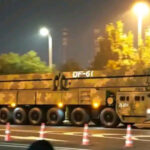At AUSA 2025 in Washington D.C., U.S.-based defense tech firm Firestorm unveiled its new “Tempest” modular drone system—a compact tactical UAV designed for rapid deployment from a single-case launcher. The system is aimed at providing frontline units with flexible ISR and loitering munition capabilities in a highly portable format. With its emphasis on modularity and ease of use, Tempest reflects broader trends in the evolution of small-unit airpower.
Tempest Concept: Modularity Meets Tactical Portability
The Tempest platform is built around a core principle of operational flexibility through modularity. The airframe can be configured for multiple mission profiles—Intelligence, Surveillance and Reconnaissance (ISR), electronic warfare (EW), or kinetic strike—by swapping payloads within minutes. This design approach allows commanders to adapt the same platform to differing mission needs without fielding multiple drone types.
According to Firestorm representatives at AUSA 2025, the entire system—including the UAV, launcher tube, ground control unit (GCU), and battery—is packaged into a single ruggedized case weighing under 25 kg. This makes it man-portable by a two-person team or easily mounted on light vehicles such as MRZRs or JLTVs.
The launch mechanism is electric and cold-launched from the tube container without pyrotechnics, reducing acoustic signature and enabling operation from enclosed or urban environments. Once airborne, the drone transitions to fixed-wing flight using fold-out wings for extended endurance.
Technical Specifications and Performance Envelope
While full specifications have not been publicly disclosed as of publication time, Firestorm provided indicative performance metrics:
- Wingspan: Approx. 1.4 meters (foldable)
- Weight: ~6 kg airframe (excluding payload)
- Endurance: Up to 90 minutes depending on configuration
- Range: Operational radius of up to 20 km LOS; potentially more with relay
- Payload Options: EO/IR gimbals; electronic warfare pods; small warhead modules (~1–2 kg)
The aircraft uses electric propulsion for low-noise operation and has autonomous waypoint navigation via GPS/INS integration. The GCU interface supports real-time video downlink and retasking mid-flight.
Kinetic Variant: Loitering Munition Configuration
A particularly notable variant of the Tempest is its loitering munition configuration. In this setup, the drone carries a small high-explosive charge designed for precision strikes against soft targets such as enemy personnel concentrations or unarmored vehicles.
This mode transforms Tempest into an affordable one-way attack asset akin to systems like AeroVironment’s Switchblade 300 but with greater payload flexibility due to its modular bay design. The munition variant includes terminal guidance options such as optical tracking or geolocation lock-on before impact.
Tactical Use Cases and Integration Potential
The compact form factor and rapid deployment profile make Tempest well-suited for dismounted infantry units operating in contested environments where traditional UAV support may be unavailable or delayed. Potential use cases include:
- Tactical ISR: Route reconnaissance ahead of patrols
- Kinetic Strike: Precision engagement of enemy firing positions
- CUE Support: Target designation for indirect fires via laser marker module (future variant)
The system’s open architecture also allows integration into existing C4ISR networks via standard protocols like MAVLink or NATO STANAG interfaces. Firestorm has indicated that it is exploring compatibility with ATAK (Android Tactical Assault Kit) for seamless battlefield coordination.
AUSA Debut Signals Growing Demand for Lightweight Multi-Role Drones
The unveiling of Tempest at AUSA aligns with broader U.S. Army modernization priorities emphasizing distributed lethality and expeditionary capabilities at the squad and platoon level. As peer adversaries invest heavily in counter-UAS systems and electronic warfare tools, there is growing interest in smaller drones that can be rapidly deployed without large logistical footprints.
The trend toward “single-case drones” reflects lessons learned from Ukraine’s battlefield innovations—where FPV drones and portable loitering munitions have proven disproportionately effective against armor and artillery systems when used en masse.
Outlook: Production Plans and Testing Timeline
Firestorm has not yet confirmed production contracts but stated it is actively engaging with U.S. Army Futures Command under Small Business Innovation Research (SBIR) pathways. Field trials are expected in early Q1 2026 with potential limited operational evaluation by late next year if procurement interest materializes.
The company also hinted at future variants including VTOL-capable models using tilt-rotor modules as well as AI-assisted targeting algorithms under development in partnership with DARPA-affiliated research labs.
Conclusion
The Tempest system represents another step toward democratizing aerial capabilities at lower echelons of combat forces through compact design philosophy and mission-adaptive architecture. Whether it sees widespread adoption will depend on cost-per-unit economics versus competing systems like Anduril’s ALTIUS-600M or AeroVironment’s Switchblade family—but its debut reinforces that lightweight modular drones are no longer niche assets but central tools in modern maneuver warfare.









